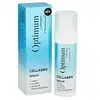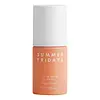What's inside
What's inside
 Key Ingredients
Key Ingredients

 Benefits
Benefits

 Concerns
Concerns

 Ingredients Side-by-side
Ingredients Side-by-side

Water
Skin ConditioningGlycerin
HumectantNiacinamide
SmoothingCaprylic/Capric Triglyceride
MaskingBetaine
HumectantDecyl Oleate
EmollientIsoamyl Laurate
EmollientCaprylyl Glycol
EmollientCarbomer
Emulsion StabilisingTriethyl Citrate
Masking3-O-Ethyl Ascorbic Acid
Skin ConditioningSodium Polyglutamate
HumectantBenzoic Acid
MaskingSodium Hydroxide
BufferingParfum
MaskingTocopheryl Acetate
AntioxidantAcrylates/C10-30 Alkyl Acrylate Crosspolymer
Emulsion StabilisingGlycine Soja Oil
EmollientDisodium EDTA
Sodium Hyaluronate
HumectantCollagen Amino Acids
MoisturisingTocopherol
AntioxidantHydroxypropyl Cyclodextrin
MaskingLeuconostoc/Radish Root Ferment Filtrate
AntimicrobialBeta-Sitosterol
Emulsion StabilisingHydroxycitronellal
PerfumingSqualene
EmollientLimonene
PerfumingAlpha-Isomethyl Ionone
PerfumingCitronellol
PerfumingEugenol
PerfumingPalmitoyl Tripeptide-38
Skin ConditioningHydrogenated Palm Glycerides Citrate
EmollientWater, Glycerin, Niacinamide, Caprylic/Capric Triglyceride, Betaine, Decyl Oleate, Isoamyl Laurate, Caprylyl Glycol, Carbomer, Triethyl Citrate, 3-O-Ethyl Ascorbic Acid, Sodium Polyglutamate, Benzoic Acid, Sodium Hydroxide, Parfum, Tocopheryl Acetate, Acrylates/C10-30 Alkyl Acrylate Crosspolymer, Glycine Soja Oil, Disodium EDTA, Sodium Hyaluronate, Collagen Amino Acids, Tocopherol, Hydroxypropyl Cyclodextrin, Leuconostoc/Radish Root Ferment Filtrate, Beta-Sitosterol, Hydroxycitronellal, Squalene, Limonene, Alpha-Isomethyl Ionone, Citronellol, Eugenol, Palmitoyl Tripeptide-38, Hydrogenated Palm Glycerides Citrate
Water
Skin ConditioningNiacinamide
SmoothingButylene Glycol
Humectant3-O-Ethyl Ascorbic Acid
Skin ConditioningAscorbyl Glucoside
AntioxidantGlycerin
HumectantCapryloyl Glycerin/Sebacic Acid Copolymer
Skin ConditioningHydroxyethyl Acrylate/Sodium Acryloyldimethyl Taurate Copolymer
Emulsion StabilisingSqualane
EmollientSodium Citrate
BufferingPhenoxyethanol
PreservativeSodium Hydroxide
BufferingCitric Acid
BufferingDiheptyl Succinate
EmollientTocopheryl Acetate
AntioxidantXanthan Gum
EmulsifyingTetrasodium Glutamate Diacetate
Carbomer
Emulsion StabilisingPolysorbate 20
EmulsifyingPalmitoyl Oligopeptide
CleansingPalmitoyl Tetrapeptide-7
Skin ConditioningCamellia Oleifera Leaf Extract
AstringentEthylhexylglycerin
Skin ConditioningOrchis Mascula Flower Extract
SoothingCaprylic/Capric Triglyceride
MaskingCananga Odorata Flower Extract
PerfumingCucumis Melo Cantalupensis Fruit Extract
AstringentEugenia Caryophyllus Flower Extract
AstringentGlycine Soja Oil
EmollientPyrus Malus Fruit Extract
Skin ConditioningPrunus Armeniaca Fruit Extract
Skin ConditioningRosa Gallica Flower Extract
AstringentCinnamomum Cassia Bark Extract
MaskingJasminum Officinale Flower/Leaf Extract
MaskingCoffea Arabica Leaf/Seed Extract
MaskingCamellia Sinensis Leaf Extract
AntimicrobialAmyl Cinnamal
PerfumingCinnamyl Alcohol
PerfumingCitronellol
PerfumingEugenol
PerfumingHydroxycitronellal
PerfumingWater, Niacinamide, Butylene Glycol, 3-O-Ethyl Ascorbic Acid, Ascorbyl Glucoside, Glycerin, Capryloyl Glycerin/Sebacic Acid Copolymer, Hydroxyethyl Acrylate/Sodium Acryloyldimethyl Taurate Copolymer, Squalane, Sodium Citrate, Phenoxyethanol, Sodium Hydroxide, Citric Acid, Diheptyl Succinate, Tocopheryl Acetate, Xanthan Gum, Tetrasodium Glutamate Diacetate, Carbomer, Polysorbate 20, Palmitoyl Oligopeptide, Palmitoyl Tetrapeptide-7, Camellia Oleifera Leaf Extract, Ethylhexylglycerin, Orchis Mascula Flower Extract, Caprylic/Capric Triglyceride, Cananga Odorata Flower Extract, Cucumis Melo Cantalupensis Fruit Extract, Eugenia Caryophyllus Flower Extract, Glycine Soja Oil, Pyrus Malus Fruit Extract, Prunus Armeniaca Fruit Extract, Rosa Gallica Flower Extract, Cinnamomum Cassia Bark Extract, Jasminum Officinale Flower/Leaf Extract, Coffea Arabica Leaf/Seed Extract, Camellia Sinensis Leaf Extract, Amyl Cinnamal, Cinnamyl Alcohol, Citronellol, Eugenol, Hydroxycitronellal
 Reviews
Reviews

Ingredients Explained
These ingredients are found in both products.
Ingredients higher up in an ingredient list are typically present in a larger amount.
You might know this ingredient as Ethyl Ascorbic Acid, a more stable version of ascorbic acid.
Like other types of vitamin C, this ingredient has many benefits including reducing wrinkles, skin soothing, dark spot fading, and fighting against free radicals.
3-O-Ethyl Ascorbic Acid interferes with the process of skin darkening, helping to reduce hyperpigmentation. It also encourages the skin to produce more collagen.
Once applied, 3-O-Ethyl Ascorbic Acid is converted to Vitamin C deeper in the skin's layers. This process is slow but makes this ingredient more tolerable for skin.
The optimum pH range for this ingredient is 4 - 5.5
Learn more about 3-O-Ethyl Ascorbic AcidThis ingredient is an emollient, solvent, and texture enhancer. It is considered a skin-softener by helping the skin prevent moisture loss.
It helps thicken a product's formula and makes it easier to spread by dissolving clumping compounds.
Caprylic Triglyceride is made by combining glycerin with coconut oil, forming a clear liquid.
While there is an assumption Caprylic Triglyceride can clog pores due to it being derived from coconut oil, there is no research supporting this.
Learn more about Caprylic/Capric TriglycerideCarbomer is a polymer of acrylic acid. Its main role is to create a gel consistency.
A high amount of carbomer can cause pilling or balling up of products. Don't worry, most products contain 1% or less of carbomer.
Citronellol is used to add fragrance/parfum to a product. It is often derived from plants such as roses. In fact, it can be found in many essential oils including geranium, lavender, neroli, and more. The scent of Citronellol is often described as "fresh, grassy, and citrus-like".
Since the Citronellol molecule is already unstable, Citronellol becomes irritating on the skin when exposed to air.
Citronellol is a modified terpene. Terpenes are unsaturated hydrocarbons found in plants. They make up the primary part of essential oils.
Citronellol is not able to be absorbed into deeper layers of the skin. It has low permeability,
Citronellol is also a natural insect repellent.
Learn more about CitronellolEugenol is naturally found in cloves, basil, and bay leaves. It is an aromatic oil used to add fragrance to a product. The scent of eugenol is described as "clove-like". Eugenol is a known EU allergen, meaning it causes contact allergies.
Studies show eugenol possesses antibacterial and antioxidant properties.
Besides cosmetics, eugenol is also added as a flavor in teas and cakes.
Learn more about EugenolGlycerin is already naturally found in your skin. It helps moisturize and protect your skin.
A study from 2016 found glycerin to be more effective as a humectant than AHAs and hyaluronic acid.
As a humectant, it helps the skin stay hydrated by pulling moisture to your skin. The low molecular weight of glycerin allows it to pull moisture into the deeper layers of your skin.
Hydrated skin improves your skin barrier; Your skin barrier helps protect against irritants and bacteria.
Glycerin has also been found to have antimicrobial and antiviral properties. Due to these properties, glycerin is often used in wound and burn treatments.
In cosmetics, glycerin is usually derived from plants such as soybean or palm. However, it can also be sourced from animals, such as tallow or animal fat.
This ingredient is organic, colorless, odorless, and non-toxic.
Glycerin is the name for this ingredient in American English. British English uses Glycerol/Glycerine.
Learn more about GlycerinGlycine Soja Oil comes from the soybean. Glycine Soja is native to eastern Asia.
Soybean oil is an emollient. It is rich in antioxidants and fatty acids including palmitic, stearic, oleic, and linoleic acids.
As an emollient, the fatty acids in soybean oil helps keep your skin soft and hydrated. It does so by creating a film on top that traps moisture in.
Soybean oil is also rich in vitamin E, a potent antioxidant. Vitamin E is also anti-inflammatory and provides a soothing effect.
Studies show soy may help fade hyperpigmentation from UVB. It does so by disrupting the melanin process from UVB induced skin inflammation.
This ingredient may not be malassezia folliculitis, or fungal-acne, safe.
Soybeans are rich in proteins and are part of the legume family. Foods made with soybeans include tofu, soymilk, edamame, miso, and soy sauce.
Learn more about Glycine Soja OilHydroxycitronellal is a fragrance created from citronellal. The smell of hydroxycitronellal is often described as "citrus-like" or "melon-like".
Hydroxycitronellal is a known EU allergen and may cause irritation when applied to the skin.
Niacinamide is a multitasking form of vitamin B3 that strengthens the skin barrier, reduces pores and dark spots, regulates oil, and improves signs of aging.
And the best part? It's gentle and well-tolerated by most skin types, including sensitive and reactive skin.
You might have heard of "niacin flush", or the reddening of skin that causes itchiness. Niacinamide has not been found to cause this.
In very rare cases, some individuals may not be able to tolerate niacinamide at all or experience an allergic reaction to it.
If you are experiencing flaking, irritation, and dryness with this ingredient, be sure to double check all your products as this ingredient can be found in all categories of skincare.
When incorporating niacinamide into your routine, look out for concentration amounts. Typically, 5% niacinamide provides benefits such as fading dark spots. However, if you have sensitive skin, it is better to begin with a smaller concentration.
When you apply niacinamide to your skin, your body converts it into nicotinamide adenine dinucleotide (NAD). NAD is an essential coenzyme that is already found in your cells as "fuel" and powers countless biological processes.
In your skin, NAD helps repair cell damage, produce new healthy cells, support collagen production, strengthen the skin barrier, and fight environmental stressors (like UV and pollution).
Our natural NAD levels start to decline with age, leading to slower skin repair, visible aging, and a weaker skin barrier. By providing your skin niacinamide, you're recharging your skin's NAD levels. This leads to stronger, healthier, and younger looking skin.
Another name for vitamin B3 is nicotinamide. This vitamin is water-soluble and our bodies don't store it. We obtain Vitamin B3 from either food or skincare. Meat, fish, wheat, yeast, and leafy greens contain vitamin B3.
The type of niacinamide used in skincare is synthetically created.
Learn more about NiacinamideSodium Hydroxide is also known as lye or caustic soda. It is used to adjust the pH of products; many ingredients require a specific pH to be effective.
In small amounts, sodium hydroxide is considered safe to use. However, large amounts may cause chemical burns due to its high alkaline.
Your skin has a natural pH and acid mantle. This acid mantle helps prevent harmful bacteria from breaking through. The acid mantle also helps keep your skin hydrated.
"Alkaline" refers to a high pH level. A low pH level would be considered acidic.
Learn more about Sodium HydroxideTocopheryl Acetate is AKA Vitamin E. It is an antioxidant and protects your skin from free radicals. Free radicals damage the skin by breaking down collagen.
One study found using Tocopheryl Acetate with Vitamin C decreased the number of sunburned cells.
Tocopheryl Acetate is commonly found in both skincare and dietary supplements.
Learn more about Tocopheryl AcetateWater. It's the most common cosmetic ingredient of all. You'll usually see it at the top of ingredient lists, meaning that it makes up the largest part of the product.
So why is it so popular? Water most often acts as a solvent - this means that it helps dissolve other ingredients into the formulation.
You'll also recognize water as that liquid we all need to stay alive. If you see this, drink a glass of water. Stay hydrated!
Learn more about Water